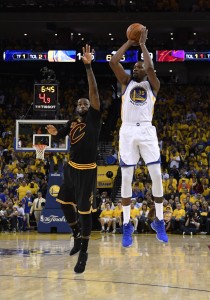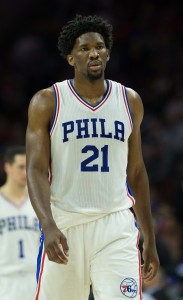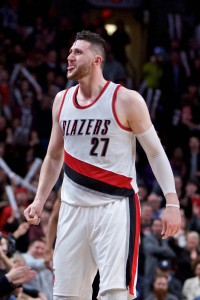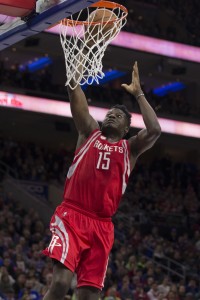The list of 2017 free agents continues to dry up, which means it’s time to shift our focus to the group of players on track to reach the free agent market in 2018. We’ve got a full list of those 2018 free-agents-to-be, divided by position and FA type, and a separate list that sorts them by team.
Since we’re still more than nine months away from the 2018 free agent period opening, those lists look a little more star-studded now than they’ll end up being. A handful of top-tier restricted free agents figure to sign extensions with their current teams before opening night in October, and it’s possible that a couple veterans will do so as well — Russell Westbrook, for instance, could ink a Designated Veteran Extension with the Thunder within the next month.
Still, even though not all of the top potential 2018 free agents will reach the open market – and not all of them will change teams if they do – the list includes enough big names that it should still look pretty impressive when next July rolls around.
Below, we’ve taken our first crack at ranking some of the top potential free agents for 2018. While this is our first extended look at 2018’s top free agents, it certainly won’t be our last. Extensions, injuries, breakout years, trades, and poor performances figure to affect these rankings over the course of the 2017/18 season, so we’ll be revisiting the list every month or two to make updates and changes.
Our list reflects each player’s current expected value on the 2018 free agent market, rather than how we think they’ll perform on the court for the 2017/18 season. For instance, older players like J.J. Redick and Dwyane Wade have solid short-term value, but didn’t make our top 20 because they’re unlikely to sign huge, long-term deals next summer. In other words, age and long-term value is important.
Here’s the first installment of our 2018 free agent power rankings:
 LeBron James, F, Cavaliers (player option): James will be 33 years old when he reaches free agency next summer, which normally would be enough to drop him a couple spots on this list. However, virtually any team in the league would still jump at the chance to give him as many years and dollars as possible next summer, since he has yet to show any real signs of slowing down.
LeBron James, F, Cavaliers (player option): James will be 33 years old when he reaches free agency next summer, which normally would be enough to drop him a couple spots on this list. However, virtually any team in the league would still jump at the chance to give him as many years and dollars as possible next summer, since he has yet to show any real signs of slowing down.- Kevin Durant, F, Warriors (player option): Of all the players on this list, Durant is probably the least likely to change teams in 2018. He’s simply going year by year with the Warriors because it makes more sense than locking himself into a long-term deal — that decision allowed him to get a raise this offseason while forgoing his maximum salary to help Golden State re-sign other key players. Nonetheless, he remains on track to technically become a free agent in 2018, so he deserves this spot, if not the one LeBron is currently holding.
- Russell Westbrook, G, Thunder (player option): Four players this offseason were eligible for the NBA’s new Designated Veteran super-max contracts — Stephen Curry, James Harden, and John Wall all signed theirs, but Westbrook has yet to put pen to paper. If he does so before opening night, he’ll come off this list and the Thunder will breathe a little easier. If not, let the rumor-mill fun begin.
- Paul George, F, Thunder (player option): While the Thunder remain optimistic about locking up Westbrook, they have no misconceptions about extending George before next July. The former Pacers forward has been long rumored to be eyeing a move to the Lakers, but what happens this season in Oklahoma City – not to mention in Los Angeles – could go a long way toward determining if that’s really his best move nine months from now.
- Chris Paul, G, Rockets: Paul was a fixture in the top five of our 2017 free agent power rankings, but when an opportunity to be traded to the Rockets arose in June, he unexpectedly opted into the final year of his contract and put off free agency for another year. It sounds like both the Rockets and Paul expect to continue their relationship beyond the 2017/18 season, but we’ve yet to see the veteran point guard play a single game with his new club, so shouldn’t necessarily pencil CP3 into Houston’s lineup for years to come quite yet.
- DeMarcus Cousins, C, Pelicans: While the Kings never came out and said it, it appeared the team wasn’t fully comfortable committing to a max (and possibly a super-max) salary for Cousins’ next contract, opting to trade him before having to make that decision. Cousins’ performance this season in New Orleans may have a significant effect on how many other teams will be ready to make such a commitment. Few NBA big men can score like Cousins, who is even developing a reliable outside shot, but he has yet to play for a winner, and if he can’t break through with another superstar teammate (Anthony Davis), that may dampen some potential suitors’ enthusiasm.
- Andrew Wiggins, G/F, Timberwolves (RFA): It’s been a somewhat unusual summer for Wiggins, who was involved in several Kyrie Irving-related trade rumors and then fired his agent after receiving a five-year, maximum salary extension offer from the Wolves. Even if he’s at all put off by owner Glen Taylor requesting a face-to-face meeting before making that commitment, Wiggins seems pretty unlikely to turn down an offer of that magnitude, so I expect him to accept it and come off this list at some point soon.

- Joel Embiid, C, Sixers (RFA): No potential 2018 free agent is trickier to evaluate than Embiid, who has famously only appeared in 31 NBA games during his first three years in the league. Of course, Embiid’s health will be a huge factor in determining whether he slips out of the top 10 during the 2017/18 season, or whether he climbs even higher. When he’s on the court, Embiid looks like the type of player who should have his pick of long-term, maximum salary offers at 12:01am on July 1. If he battles injuries once more though, those offers may be for a shorter term or packed with games-played incentives — and if his health issues get even worse, those offers may not be on the table at all.
- Avery Bradley, G, Pistons: Bradley isn’t at the same level as guys like Kyrie Irving or Gordon Hayward, so it makes sense that the Celtics were willing to part with him in order to secure more All-Star caliber talent. But Bradley is a dynamic two-way threat who shot 39.0% from three-point range and plays strong defense. That type of player is extremely valuable in today’s NBA, making him highly coveted on the open market in 2018.
- Gary Harris, G, Nuggets (RFA): Harris’ numbers don’t pop off the stat sheet, but neither did Otto Porter‘s, and Harris had a more effective third NBA season than the Wizards forward, who signed a maximum salary offer sheet earlier this year. Having just turned 23, Harris has plenty of room to improve on last year’s 14.9 PPG and .420 3PT%, and could be one of the hottest commodities on the RFA market next summer if the Nuggets don’t extend him this year.
Here’s the rest of our top 20:
- Jusuf Nurkic, C, Trail Blazers (RFA)
- Jabari Parker, F, Bucks (RFA)
- Clint Capela, C, Rockets (RFA)
- Isaiah Thomas, G, Cavaliers
- DeAndre Jordan, C, Clippers (player option)
- Zach LaVine, G, Bulls
- LaMarcus Aldridge, F/C, Spurs (player option)
- Brook Lopez, C, Lakers
- Carmelo Anthony, F, Knicks (player option)
- Rodney Hood, G, Jazz (RFA)
Disagree strongly with any of our rankings? Feel like we omitted any players that should be in the top 20 (or the top 10)? Weigh in below in the comments section to let us know!
Photos courtesy of USA Today Sports Images.

